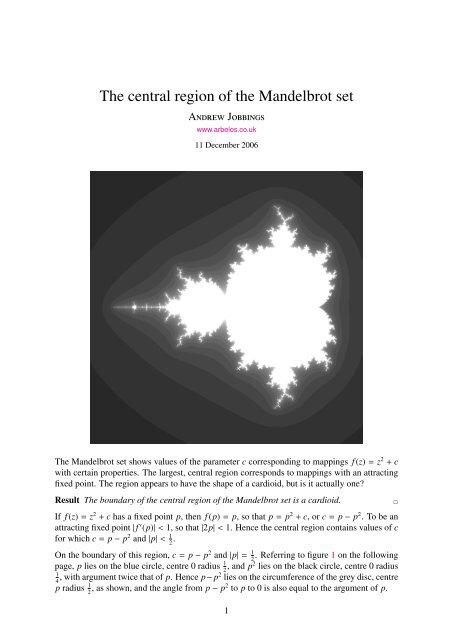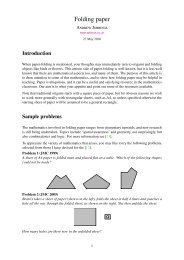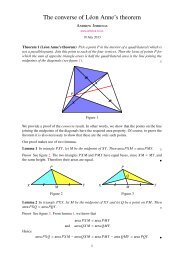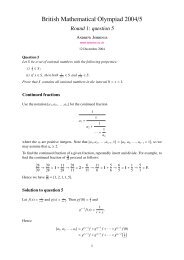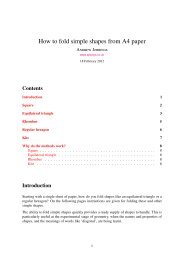The central region of the Mandelbrot set - Arbelos
The central region of the Mandelbrot set - Arbelos
The central region of the Mandelbrot set - Arbelos
Create successful ePaper yourself
Turn your PDF publications into a flip-book with our unique Google optimized e-Paper software.
<strong>The</strong> <strong>central</strong> <strong>region</strong> <strong>of</strong> <strong>the</strong> <strong>Mandelbrot</strong> <strong>set</strong><br />
Andrew Jobbings<br />
www.arbelos.co.uk<br />
11 December 2006<br />
<strong>The</strong> <strong>Mandelbrot</strong> <strong>set</strong> shows values <strong>of</strong> <strong>the</strong> parameter c corresponding to mappings f (z) = z 2 + c<br />
with certain properties. <strong>The</strong> largest, <strong>central</strong> <strong>region</strong> corresponds to mappings with an attracting<br />
fixed point. <strong>The</strong> <strong>region</strong> appears to have <strong>the</strong> shape <strong>of</strong> a cardioid, but is it actually one?<br />
Result <strong>The</strong> boundary <strong>of</strong> <strong>the</strong> <strong>central</strong> <strong>region</strong> <strong>of</strong> <strong>the</strong> <strong>Mandelbrot</strong> <strong>set</strong> is a cardioid.<br />
If f (z) = z 2 + c has a fixed point p, <strong>the</strong>n f (p) = p, so that p = p 2 + c, or c = p − p 2 . To be an<br />
attracting fixed point | f ′ (p)| < 1, so that |2p| < 1. Hence <strong>the</strong> <strong>central</strong> <strong>region</strong> contains values <strong>of</strong> c<br />
for which c = p − p 2 and |p| < 1 2 .<br />
On <strong>the</strong> boundary <strong>of</strong> this <strong>region</strong>, c = p − p 2 and |p| = 1 . Referring to figure 1 on <strong>the</strong> following<br />
2<br />
page, p lies on <strong>the</strong> blue circle, centre 0 radius 1, and 2 p2 lies on <strong>the</strong> black circle, centre 0 radius<br />
1<br />
, with argument twice that <strong>of</strong> p. Hence p− 4 p2 lies on <strong>the</strong> circumference <strong>of</strong> <strong>the</strong> grey disc, centre<br />
p radius 1, as shown, and <strong>the</strong> angle from p − 2 p2 to p to 0 is also equal to <strong>the</strong> argument <strong>of</strong> p.<br />
1<br />
✷
www.arbelos.co.uk/papers.html c○ Andrew Jobbings 2006<br />
p p 2<br />
p<br />
Θ<br />
Θ<br />
Θ<br />
p 2<br />
0 1<br />
4<br />
Figure 1<br />
This corresponds precisely with <strong>the</strong> definition <strong>of</strong> a cardioid as an epicycloid—<strong>the</strong> locus <strong>of</strong> a<br />
point on <strong>the</strong> circumference <strong>of</strong> a disc as it rolls around an equal disc. Here <strong>the</strong> grey disc rolls<br />
around <strong>the</strong> black circle, starting with <strong>the</strong> point at 1 4 and <strong>the</strong> centre <strong>of</strong> <strong>the</strong> rolling disc at 1 2 . <br />
An alternative derivation is possible by writing p = 1 (cos θ + i sin θ) in order to find c and <strong>the</strong><br />
2<br />
equation <strong>of</strong> <strong>the</strong> curve.<br />
2


